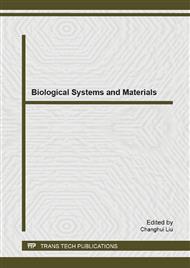p.60
p.65
p.71
p.75
p.80
p.86
p.91
p.96
p.104
Effects of Cu Doping on the Microstructure and Electrical Properties of Sr3YCo4O10.5+δ Polycrystalline
Abstract:
Polycrystalline samples of Sr3YCo4-xCuxO10.5+δ (x=0, 0.2, 0.4, 0.6) have been prepared by solid state reaction method. Crystal structure has been checked by X-ray diffraction (XRD) and the results indicate that Sr3YCo4-xCuxO10.5+δ (x=0, 0.2, 0.4) with single phase have been synthesized in air, and the lattice parameters of Sr3YCo4-xCuxO10.5+δ (x=0, 0.2, 0.4) increase with increasing Cu content. Microstructure analysis demonstrates that the grain sizes enlarge and the number of pores decreases with increasing Cu content. The change of porous structure with different Cu contents is discussed by the liquid sintering theory. The temperature dependence of resistivity (ρ-T) curves of Sr3YCo4-xCuxO10.5+δ show nonmetallic behavior. And the electrical resistivity decreases successively with increasing Cu content, which is caused by the porous structure scattering the carriers as well as the increase of hole carriers.
Info:
Periodical:
Pages:
80-85
Citation:
Online since:
May 2014
Authors:
Price:
Сopyright:
© 2014 Trans Tech Publications Ltd. All Rights Reserved
Share:
Citation:


